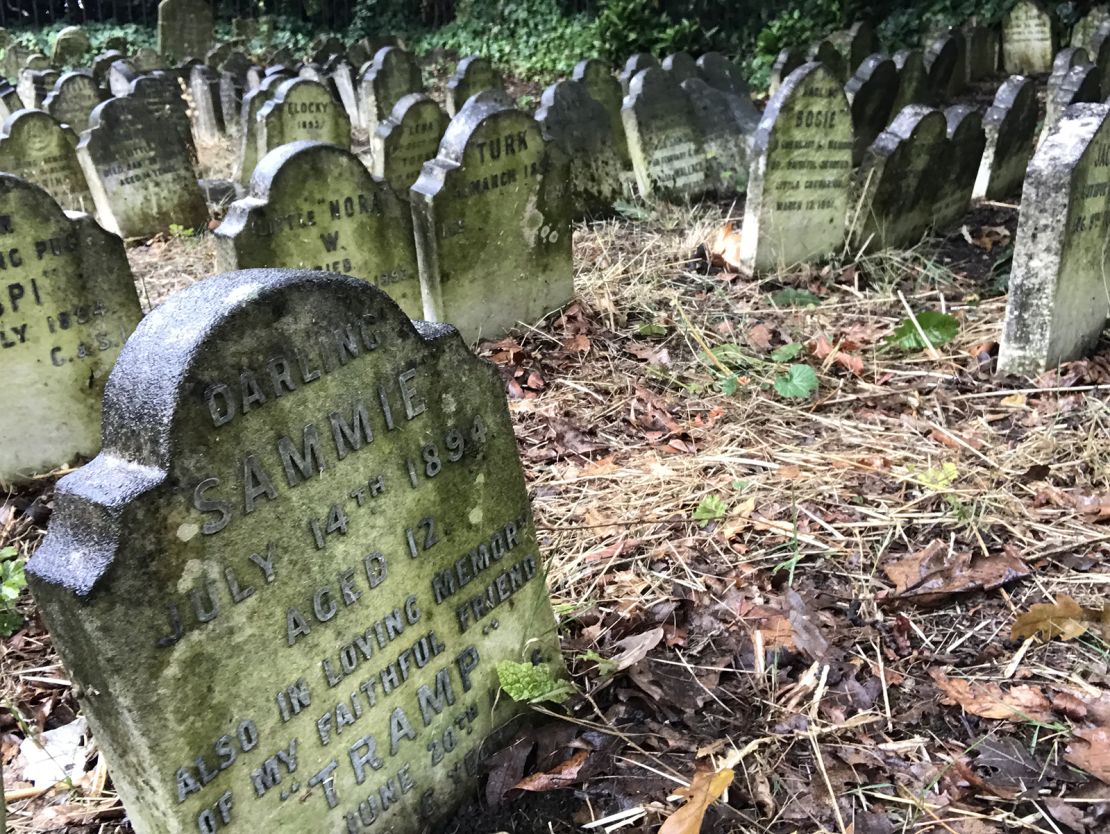Editor’s note: Eric Tourigny is a lecturer in historical archeology at the University of Newcastle, UK. His research interprets remains of osteological and material culture alongside historical texts to examine the evolution of human-animal relationships in Europe and North America over the past 500 years. The opinions expressed in this comment are his own. Read more opinions on CNN.
CNN
—
Why do we bury our deceased loved ones in a cemetery? A primary goal is to provide survivors with an opportunity to grieve and gain a sense of closure. The cemetery is a place for the living as well as the dead.
But what happens when the deceased are not humans, but our pets?

The Spanish city of Barcelona recently announced that it would invest in the creation of the country’s first public pet cemetery. Scheduled to open next year, it will offer both burials and cremations – with around 7,000 operations carried out each year.
For me, who has spent years studying the development of pet cemeteries elsewhere in the world, this news came as a shock. Barcelona is a densely populated city with little private land – a city where 50% of families own a pet.
How does a city that is home to 180,000 dogs not already have a public pet cemetery? Until now, the service was only provided by the private sector, according to the city councilor for climate emergency and ecological transition of Barcelona, Eloi Badia. He added that the municipally funded initiative was triggered by “constant public demand”.
After all, public pet cemeteries have existed in Europe and the Americas since the late 19th century. Britain’s first public animal cemetery appeared in Hyde Park in London in 1881. Hartsdale Animal Cemetery in New York was founded in 1896, followed a few years later by the rich Paris Dog Cemetery in 1899.
I became interested in the history of modern pet burial practices while investigating the archaeological record of a centuries-old house in Toronto. I came across a (very) large dog buried in the back garden which, according to historical records, was occupied between 1840 and 1870.
This dog survived into old age but unfortunately suffered from degenerative joint disease and serious infections in his final months. His illnesses progressed to a state that suggests he received some level of care during his final weeks. He was then buried in a personal plot behind the family home.
This elderly dog got me thinking about the different ways people interact with their pets’ bodies after they die. Could this behavior reflect the relationships they had with their animals during their lives? In this case, why take the time to carefully bury a dog in its own space when other, arguably simpler, options existed?

After all, it was a time when people often threw their dead animals into the river or sold their bodies for meat and skin.
Good hygiene is an obvious reason for choosing a burial – no one wants rotting animal corpses on the street or in their garden – but that wouldn’t immediately justify a personalized, dedicated burial and headstone.
The simplest option would be to throw away a deceased animal with household waste. But such treatment would obviously seem less ceremonious and would not provide appropriate emotional closure to what was likely an important relationship.
Like the burial of people, the burial of pets is an intimate cultural practice, which evolves over time and reflects the changing relationships a society has with its beloved creatures.
My study of historic tombstones and epitaphs in Britain, from the Victorian period to today, shows this changing relationship between man and animal. In the 19th century, headstones were often dedicated to a “loving friend” or “devoted companion”, suggesting that pets were generally considered important friends.
By the early 20th century, pets had become members of the family, as evidenced by the appearance of family names on tombstones and affectionate epitaphs written by “Mom and Dad.”
We can also see a change in society’s attitude towards the role of animals in the afterlife. A few decades later, headstones were more likely to refer to a meeting than previous ones. For example, the owners of Denny, the “brave little cat” buried in an east London cemetery in 1952, wrote on his epitaph “God bless you until we meet again”.
I wonder what the epitaphs in Barcelona’s new cemetery will reveal about modern Catalan relationships with animals.
Over time, our ways of treating our dead animals seem to reflect an even closer relationship in life. Once strictly prohibited by law, the last decade has seen many jurisdictions, such as New York State, permit the joint burial of animals and cremated people, which will undoubtedly lead to changing burial and memorialization practices for both humans and animals.
For me, the most remarkable similarity between modern and historic pet cemeteries is the striking evidence of the grief and taboos surrounding animal mourning.
The bond a person has with their pet can be just as strong and as important as their relationships with other humans. Yet today, as over 100 years ago, individuals continue to struggle to find the appropriate outlet to express their pain, hiding their grief out of fear of the social repercussions that might come from publicly acknowledging the existence of such a connection.
The RSPCA reassures the public on its website that they should not be ashamed of their grief. In the UK, charities such as the Blue Cross and Rainbow Bridge Pet Loss Grief Center offer counseling to bereaved people.
Close relationships between humans and animals have existed for millennia, but in Western European cultures there were few acceptable ways to mourn this relationship. As society increasingly accepts the importance of human-animal relationships to our collective well-being, it is not surprising to see us follow rituals similar to those we use to mourn the loss of our closest human relationships.
At an estimated cost of €200 ($217) per service at the new Barcelona cemetery, it is important to recognize that this opportunity to grieve will not be financially accessible to all residents of the city.
It won’t be a space for every pet in town. Pet owners can choose to keep cremated remains in their home or scatter their ashes in a meaningful location. Online forums and digital pet cemeteries also provide other opportunities to memorialize the relationship and express grief.
Whether or not one chooses a pet cemetery, there are many acceptable ways to express your grief and remember your relationship with the important animals in your life.









